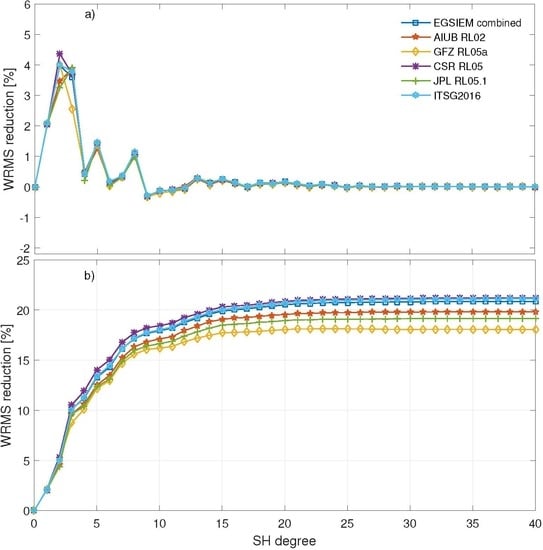Validation of the EGSIEM GRACE Gravity Fields Using GNSS Coordinate Timeseries and In-Situ Ocean Bottom Pressure Records
Abstract
1. Introduction
2. Methodology
2.1. Concept of Validation
2.2. Metrics for Performance Evaluation
2.2.1. Correlation
2.2.2. WRMS Reduction and Its Variants
2.2.3. Standard Deviation Reduction
3. Datasets
3.1. GRACE Gravity Products
3.2. GNSS Time Series
3.3. OBP Records
4. Validation Using GNSS Time Series
4.1. Full Signal Level
4.2. Annual Signal Level
4.3. Validation over Common GNSS Stations
5. Validation Using OBP Records
6. Discussion
6.1. Comparison to the Previous Comparison Studies of GNSS and GRACE
6.2. Degree and Cumulative Degree WRMS Reductions
6.3. Consistency of Validation between GNSS and OBP
7. Conclusions
Supplementary Materials
Author Contributions
Funding
Acknowledgments
Conflicts of Interest
Abbreviations
| AC | Analysis Center |
| AIUB | Astronomical Institute, University of Bern |
| COST-G | International Combination Service for Time-variable Gravity fields |
| CSR | Center for Space Research, Austin, Texas |
| EGSIEM | European Gravity Service for Improved Emergency Management |
| EU | European Union |
| GAC | Geopotential coefficients of averaged combination of non-tidal atmosphere and ocean |
| GAD | Geopotential coefficients of averaged combination of bottom pressure over oceans |
| GFZ | Helmholtz Centre Potsdam, German Research Centre for Geosciences |
| GIA | Global Isostatic Adjustment |
| GGM | Global Geopotential Model |
| GNSS | Global Navigation Satellite System |
| GPS | Global Positioning System |
| GRACE | Gravity Recovery and Climate Experiment |
| GSM | Geopotential coefficients of GRACE-derived gravity field |
| IGFS | International Gravity Field Service |
| IGS | International GNSS Service |
| ITRF | International Terrestrial Reference Frame |
| JPL | Jet Propulsion Laboratory, Pasadena, California, USA |
| KESS | Kuroshio Extension System Study |
| MPIOM | Max Planck Institute Ocean Model |
| NEU | North East Up |
| OBP | Ocean Bottom Pressure |
| RMS | Root Mean Square |
| SHC | Spherical Harmonic Coefficient |
| SLR | Satellite Laser Ranging |
| STD | Standard Deviation |
| UBERN | University of Bern |
| WRMS | Weighted Root-Mean-Square |
References
- Tapley, B.D.; Bettadpur, S.; Ries, J.C.; Thompson, P.F.; Watkins, M.M. GRACE Measurements of Mass Variability in the Earth System. Science 2004, 305, 503–505. [Google Scholar] [CrossRef] [PubMed]
- Jäggi, A. European Gravity Service for Improved Emergency Management (EGSIEM)-from concept to implementation. Geophys. J. Int. 2018. submitted. [Google Scholar]
- Jean, Y.; Meyer, U.; Jäggi, A. Combination of GRACE monthly gravity field solutions from different processing strategies. J. Geod. 2018, 1–16. [Google Scholar] [CrossRef]
- Meyer, U.; Jean, Y.; Jäggi, A. Combination of GRACE monthly gravity fields on normal equation level. J. Geod. 2018. submitted. [Google Scholar]
- Davis, J.L.; Elósegui, P.; Mitrovica, J.X.; Tamisiea, M.E. Climate-driven deformation of the solid Earth from GRACE and GPS. Geophys. Res. Lett. 2004, 31, L24605. [Google Scholar] [CrossRef]
- van Dam, T.; Wahr, J.; Lavallée, D. A comparison of annual vertical crustal displacements from GPS and Gravity Recovery and Climate Experiment (GRACE) over Europe. J. Geophys. Res. 2007, 112, B03404. [Google Scholar] [CrossRef]
- Tregoning, P.; Watson, C.; Ramillien, G.; McQueen, H.; Zhang, J. Detecting hydrologic deformation using GRACE and GPS. Geophys. Res. Lett. 2009, 36, L15401. [Google Scholar] [CrossRef]
- Tesmer, V.; Steigenberger, P.; van Dam, T.; Mayer-Gürr, T. Vertical deformations from homogeneously processed GRACE and global GPS long-term series. J. Geod. 2011, 85, 291–310. [Google Scholar] [CrossRef]
- Gu, Y.; Fan, D.; You, W. Comparison of observed and modeled seasonal crustal vertical displacements derived from multi-institution GPS and GRACE solutions. Geophys. Res. Lett. 2017, 44, 7219–7227. [Google Scholar] [CrossRef]
- Chanard, K.; Fleitout, L.; Calais, E.; Rebischung, P.; Avouac, J.P. Toward a Global Horizontal and Vertical Elastic Load Deformation Model Derived from GRACE and GNSS Station Position Time Series. J. Geophys. Res. Solid Earth 2018, 123, 3225–3237. [Google Scholar] [CrossRef]
- Fu, Y.; Freymueller, J.T.; Jensen, T. Seasonal hydrological loading in southern Alaska observed by GPS and GRACE. Geophys. Res. Lett. 2012, 39, L15310. [Google Scholar] [CrossRef]
- Chen, Q. Analyzing and Modmodel Environmental Loading Induced Displacements with GPS and GRACE. Ph.D. Thesis, University of Stuttgart, Stuttgart, Germany, 2015. [Google Scholar]
- Chambers, D.P.; Wahr, J.; Nerem, R.S. Preliminary observations of global ocean mass variations with GRACE. Geophys. Res. Lett. 2004, 31, L13310. [Google Scholar] [CrossRef]
- Kanzow, T.; Flechtner, F.; Chave, A.; Schmidt, R.; Schwintzer, P.; Send, U. Seasonal variation of ocean bottom pressure derived from Gravity Recovery and Climate Experiment (GRACE): Local validation and global patterns. J. Geophys. Res. 2005, 110. [Google Scholar] [CrossRef]
- Rietbroek, R.; LeGrand, P.; Wouters, B.; Lemoine, J.M.; Ramillien, G.; Hughes, C.W. Comparison of in situ bottom pressure data with GRACE gravimetry in the Crozet-Kerguelen region. Geophys. Res. Lett. 2006, 33. [Google Scholar] [CrossRef]
- Dobslaw, H.; Flechtner, F.; Bergmann-Wolf, I.; Dahle, C.; Dill, R.; Esselborn, S.; Sasgen, I.; Thomas, M. Simulating high-frequency atmosphere-ocean mass variability for dealiasing of satellite gravity observations: AOD1B RL05. J. Geophys. Res. Oceans 2013, 118, 3704–3711. [Google Scholar] [CrossRef]
- Dobslaw, H.; Bergmann-Wolf, I.; Dill, R.; Poropat, L.; Thomas, M. A new high-resolution model of non-tidal atmosphere and ocean mass variability for de-aliasing of satellite gravity observations: AOD1B RL06. Geophys. J. Int. 2017, 211, 263–269. [Google Scholar] [CrossRef]
- Poropat, L.; Dobslaw, H.; Zhang, L.; Macrander, A.; Boebel, O.; Thomas, M. Time variations in ocean bottom pressure from a few hours to many years: In situ data, numerical models, and GRACE satellite gravimetry. J. Geophys. Res. Oceans 2018, 123, 5612–5623. [Google Scholar] [CrossRef]
- Ray, J.; Altamimi, Z.; Collilieux, X.; van Dam, T. Anomalous harmonics in the spectra of GPS position estimates. GPS Solut. 2008, 12, 55–64. [Google Scholar] [CrossRef]
- Ray, J.; Griffiths, J.; Collilieux, X.; Rebischung, P. Subseasonal GNSS positioning errors. Geophys. Res. Lett. 2013, 40, 5854–5860. [Google Scholar] [CrossRef]
- van Dam, T.M.; Blewitt, G.; Heflin, M.B. Atmospheric pressure loading effects on Global Positioning System coordinate determinations. J. Geophys. Res. 1994, 99, 23939–23950. [Google Scholar] [CrossRef]
- van Dam, T.; Wahr, J.; Milly, P.C.D.; Shmakin, A.B.; Blewitt, G.; Lavallée, D.; Larson, K.M. Crustal displacements due to continental water loading. Geophys. Res. Lett. 2001, 28, 651–654. [Google Scholar] [CrossRef]
- Farrell, W.E. Deformation of the Earth by surface loads. Rev. Geophys. 1972, 10, 761–797. [Google Scholar] [CrossRef]
- Wahr, J.; Molenaar, M.; Bryan, F. Time variability of the Earth’s gravity field: Hydrological and oceanic effects and their possible detection using GRACE. J. Geophys. Res. 1998, 103, 30205–30229. [Google Scholar] [CrossRef]
- Mayer-Gürr, T.; Zehentner, N.; Klinger, B.; Kvas, A. ITSG-Grace2014: A new GRACE gravity field release computed in Graz. In Proceedings of the GRACE Science Team Meeting (GSTM), Potsdam, Germany, 29 Sepember–1 October 2014. [Google Scholar]
- Mayer-Gürr, T.; Behzadpour, S.; Ellmer, M.; Kvas, A.; Klinger, B.; Zehentner, N. ITSG-Grace2016–Monthly and Daily Gravity Field Solutions from GRACE. GFZ Data Services, 2016. Available online: https://graz.pure.elsevier.com/en/publications/itsg-grace2016-monthly-and-daily-gravity-field-solutions-from-gra (accessed on 20 August 2018).
- Bettadpur, S. UTCSR Level-2 Processing Standards Document; Technical Report; Center for Space Research, University of Texas: Austin, TX, USA, 2012. [Google Scholar]
- Dahle, C.; Flechtner, F.; Gruber, C.; König, D.; König, R.; Michalak, G.; Neumayer, K. GFZ GRACE Level-2 Processing Standards Document for Level-2 Product Release 005; GFZ Data Services: Potsdam, Germany, 2012. [Google Scholar]
- Watkins, M.; Yuan, T.D. JPL Level-2 Processing Standards Document for Level-2 Product Release 05; Technical Report; NASA JPL: Pasadena, CA, USA, 2012.
- Meyer, U.; Jäggi, A.; Jean, Y.; Beutler, G. AIUB-RL02: An improved time series of monthly gravity fields from GRACE data. Geophys. J. Int. 2016. [Google Scholar] [CrossRef]
- Cheng, M.; Tapley, B.D.; Ries, J.C. Deceleration in the Earth’s oblateness. J. Geophys. Res. Solid Earth 2013, 118, 740–747. [Google Scholar] [CrossRef]
- Swenson, S.; Chambers, D.; Wahr, J. Estimating geocenter variations from a combination of GRACE and ocean model output. J. Geophys. Res. 2008, 113, B08410. [Google Scholar] [CrossRef]
- Blewitt, G. Self-consistency in reference frames, geocenter definition, and surface loading of the solid Earth. J. Geophys. Res. 2003, 108, 2103. [Google Scholar] [CrossRef]
- Jekeli, C. Alternative Methods to Smooth the Earth’s Gravity Field; Technical Report 327; Department of Geodetic Science and Surveying, The Ohio State University: Columbus, OH, USA, 1981. [Google Scholar]
- Bergmann-Wolf, I.; Zhang, L.; Dobslaw, H. Global Eustatic Sea-Level Variations for the Approximation of Geocenter Motion from Grace. J. Geod. Sci. 2014, 4, 37–48. [Google Scholar] [CrossRef]
- Paulson, A.; Zhong, S. Inference of mantle viscosity from GRACE and relative sea level data. Geophys. J. Int. 2007, 171, 497–508. [Google Scholar] [CrossRef]
- Tanaka, Y.; Suzuki, T.; Imanishi, Y.; Okubo, S.; Zhang, X.; Ando, M.; Watanabe, A.; Saka, M.; Kato, C.; Oomori, S.; et al. Temporal gravity anomalies observed in the Tokai area and a possible relationship with slow slips. Earth Planets Space 2018, 70. [Google Scholar] [CrossRef]
- Kusche, J.; Schmidt, R.; Petrovic, S.; Rietbroek, R. Decorrelated GRACE time-variable gravity solutions by GFZ, and their validation using a hydrological model. J. Geod. 2009, 83, 903–913. [Google Scholar] [CrossRef]
- Sušnik, A.; Grahsl, A.; Arnold, D.; Villiger, A.; Dach, R.; Jäggi, A. GNSS reprocessing campaign in the framework of the EGSIEM project. J. Geod. 2017. submitted. [Google Scholar]
- Rebischung, P.; Altamimi, Z.; Ray, J.; Garayt, B. The IGS contribution to ITRF2014. J. Geod. 2016, 90, 611–630. [Google Scholar] [CrossRef]
- Bock, Y.; Webb, F. MEaSUREs Solid Earth Science ESDR System. 2012. Available online: ftp://garner.ucsd.edu/pub/timeseries/measures/ats/Global/ (accessed on 20 May 2016).
- Macrander, A.; Böning, C.; Boebel, O.; Schröter, J. Validation of GRACE Gravity Fields by In-Situ Data of Ocean Bottom Pressure. In System Earth via Geodetic-Geophysical Space Techniques; Springer: Berlin/Heidelberg, Germany, 2010; pp. 169–185. [Google Scholar]
- Pawlowicz, R.; Beardsley, B.; Lentz, S. Classical tidal harmonic analysis including error estimates in MATLAB using T_TIDE. Comput. Geosci. 2002, 28, 929–973. [Google Scholar] [CrossRef]
- Böning, C.; Timmermann, R.; Macrander, A.; Schröter, J. A pattern-filtering method for the determination of ocean bottom pressure anomalies from GRACE solutions. Geophys. Res. Lett. 2008, 35. [Google Scholar] [CrossRef]
- Han, S.C. Seasonal clockwise gyration and tilt of the Australian continent chasing the center of mass of the Earth’s system from GPS and GRACE. J. Geophys. Res. Solid Earth 2016. [Google Scholar] [CrossRef]
- King, M.; Moore, P.; Clarke, P.; Lavallée, D. Choice of optimal averaging radii for temporal GRACE gravity solutions, a comparison with GPS and satellite altimetry. Geophys. J. Int. 2006, 166, 1–11. [Google Scholar] [CrossRef]
- Nordman, M.; Mäkinen, J.; Virtanen, H.; Johansson, J.M.; Bilker-Koivula, M.; Virtanen, J. Crustal loading in vertical GPS time series in Fennoscandia. J. Geodyn. 2009, 48, 144–150. [Google Scholar] [CrossRef]
- Penna, N.T.; King, M.A.; Stewart, M.P. GPS height time series: Short-period origins of spurious long-period signals. J. Geophys. Res. 2007, 112. [Google Scholar] [CrossRef]
- Sośnica, K.; Jäggi, A.; Meyer, U.; Thaller, D.; Beutler, G.; Arnold, D.; Dach, R. Time variable Earth’s gravity field from SLR satellites. J. Geod. 2015, 89, 1–16. [Google Scholar] [CrossRef]
- Flechtner, F.; Neumayer, K.H.; Dahle, C.; Dobslaw, H.; Fagiolini, E.; Raimondo, J.C.; Güntner, A. What Can be Expected from the GRACE-FO Laser Ranging Interferometer for Earth Science Applications? Surv. Geophys. 2016, 37, 453–470. [Google Scholar] [CrossRef]
- Dahle, C.; Flechtner, F.; Murböck, M.; Michalak, G.; Neumayer, H.; Abrykosov, O.; Reinhold, A.; König, R. GFZ Level-2 Processing Standards Document For Level-2 Product Release 06; Technical Report; GFZ German Research Centre for Geosciences: Potsdam, Germany, 2018. [Google Scholar]
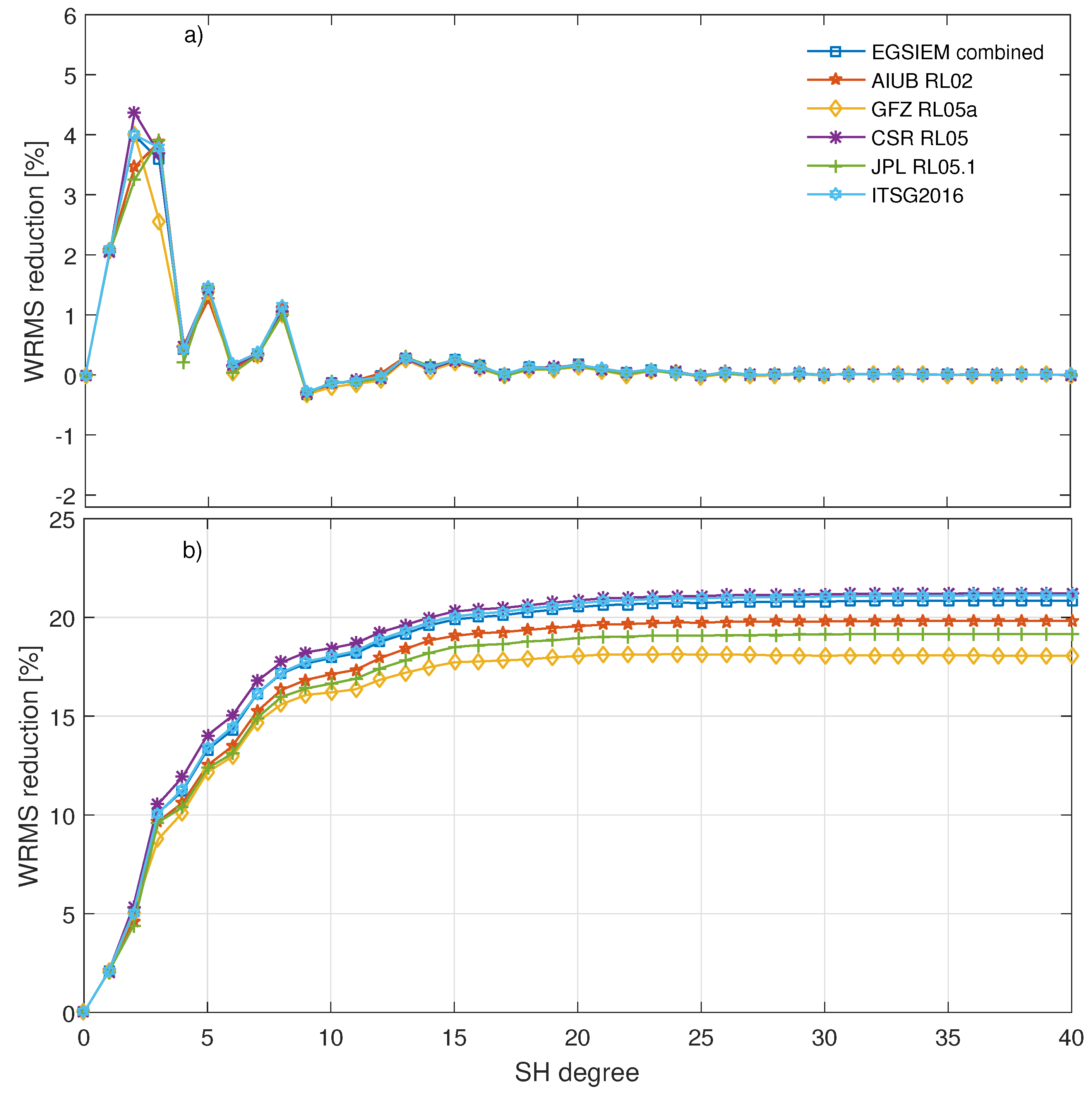
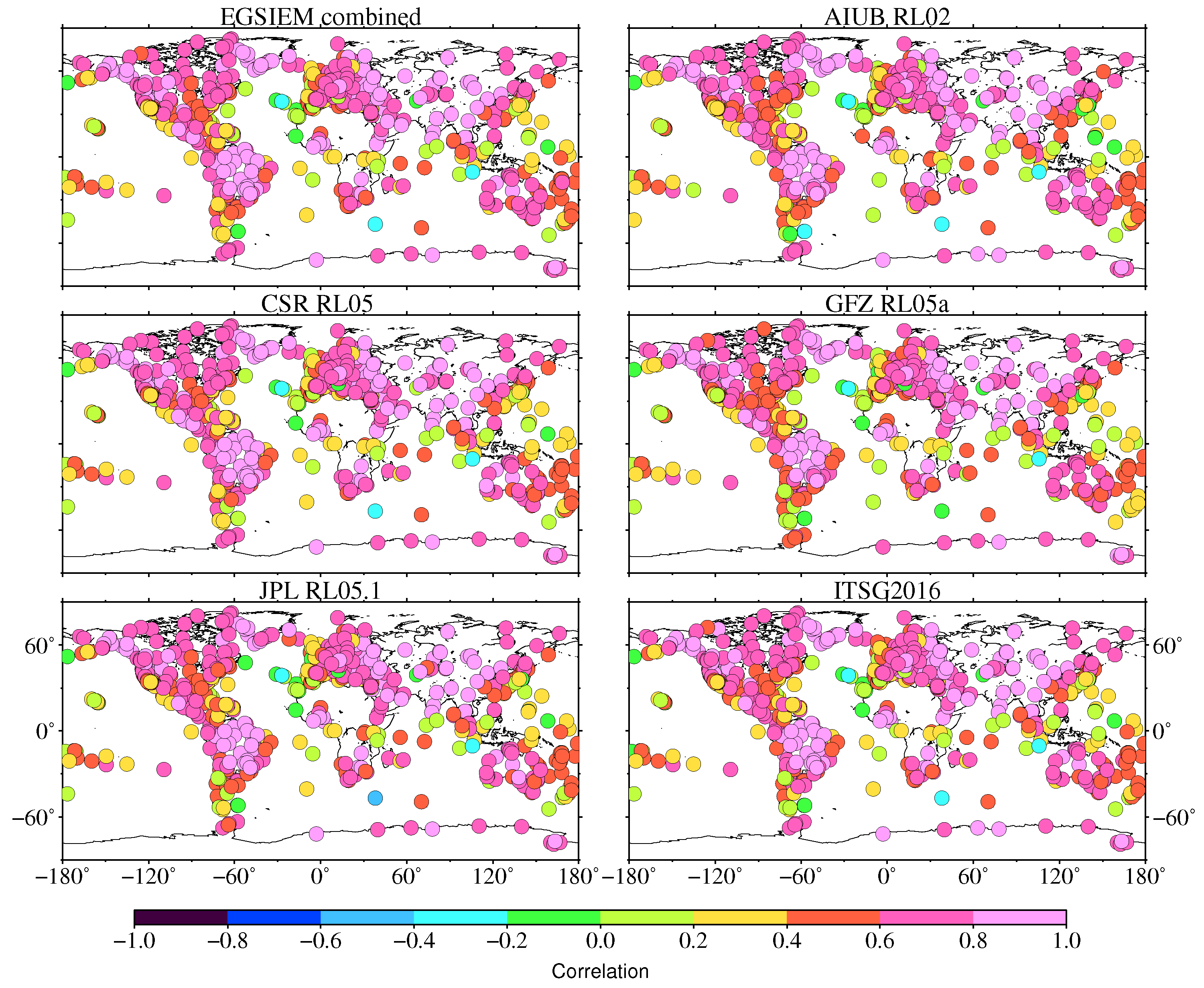
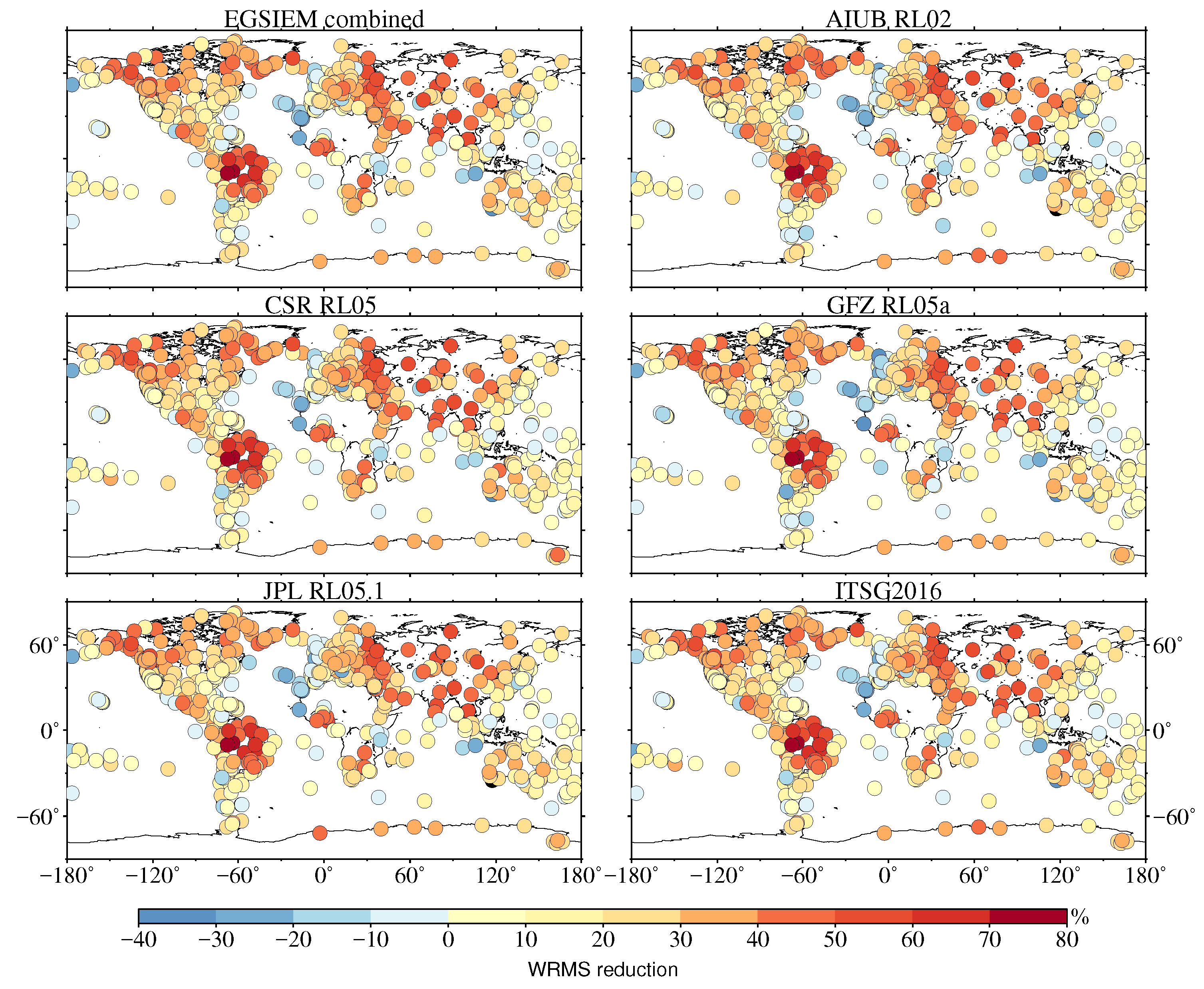

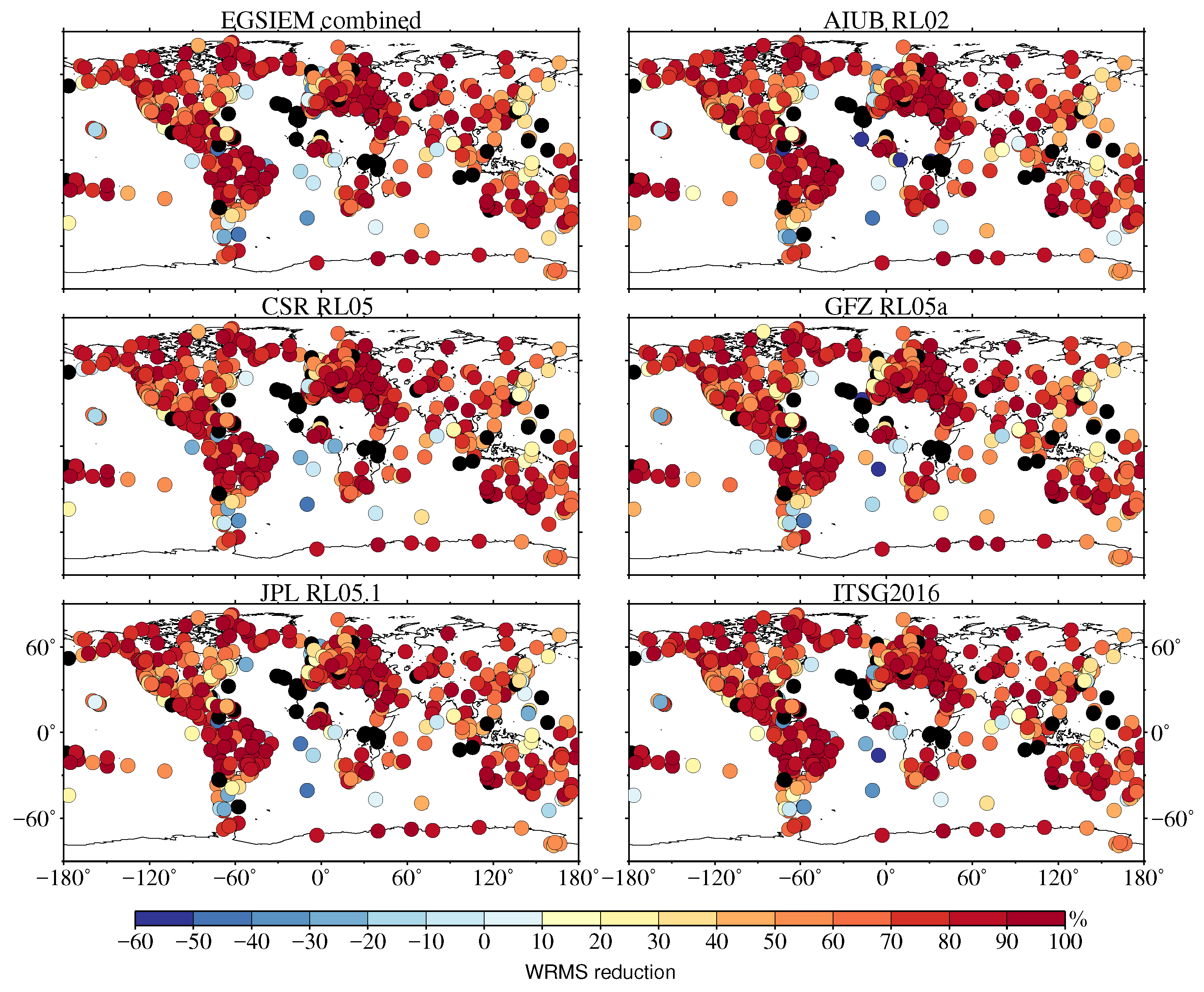
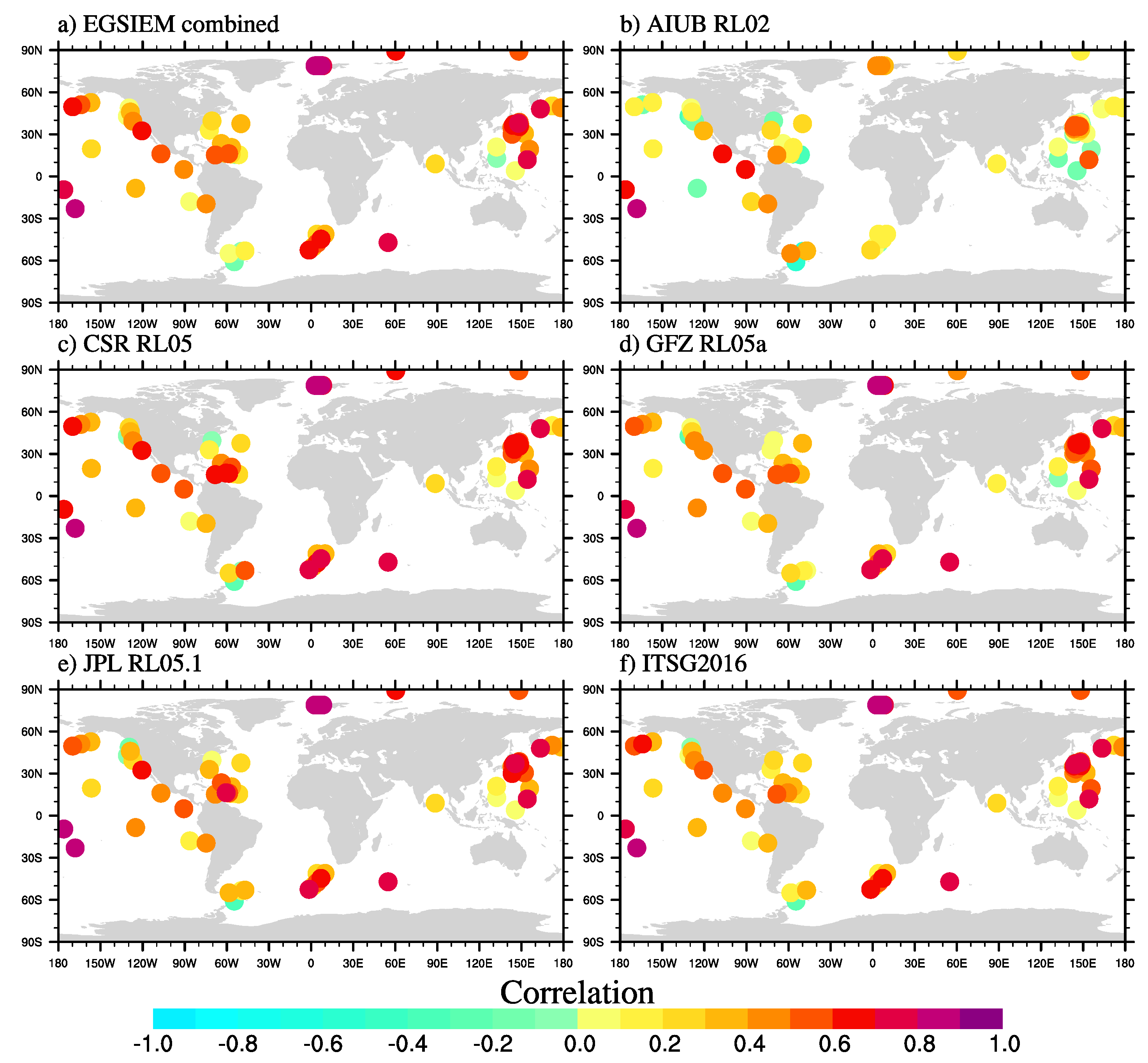
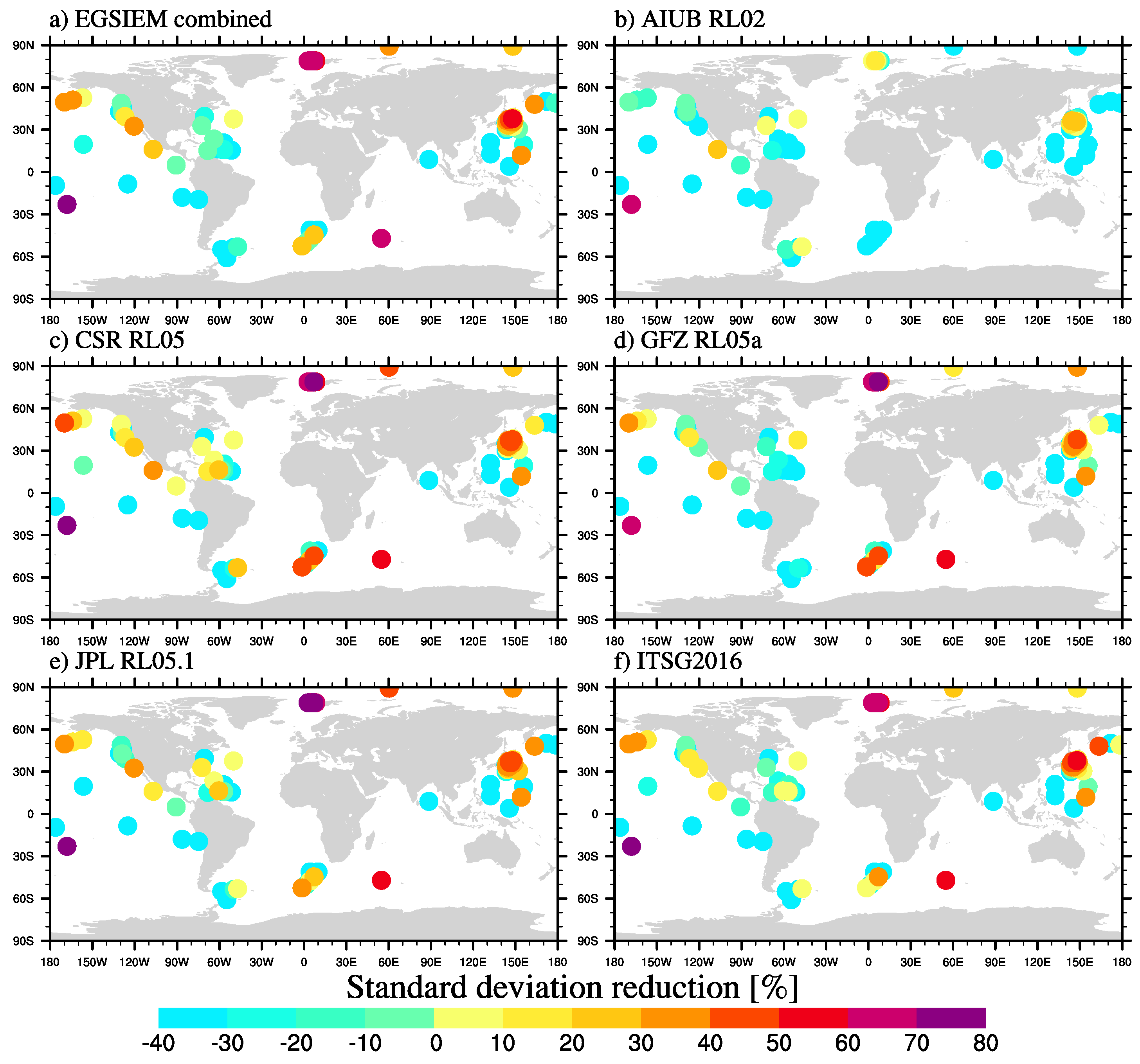
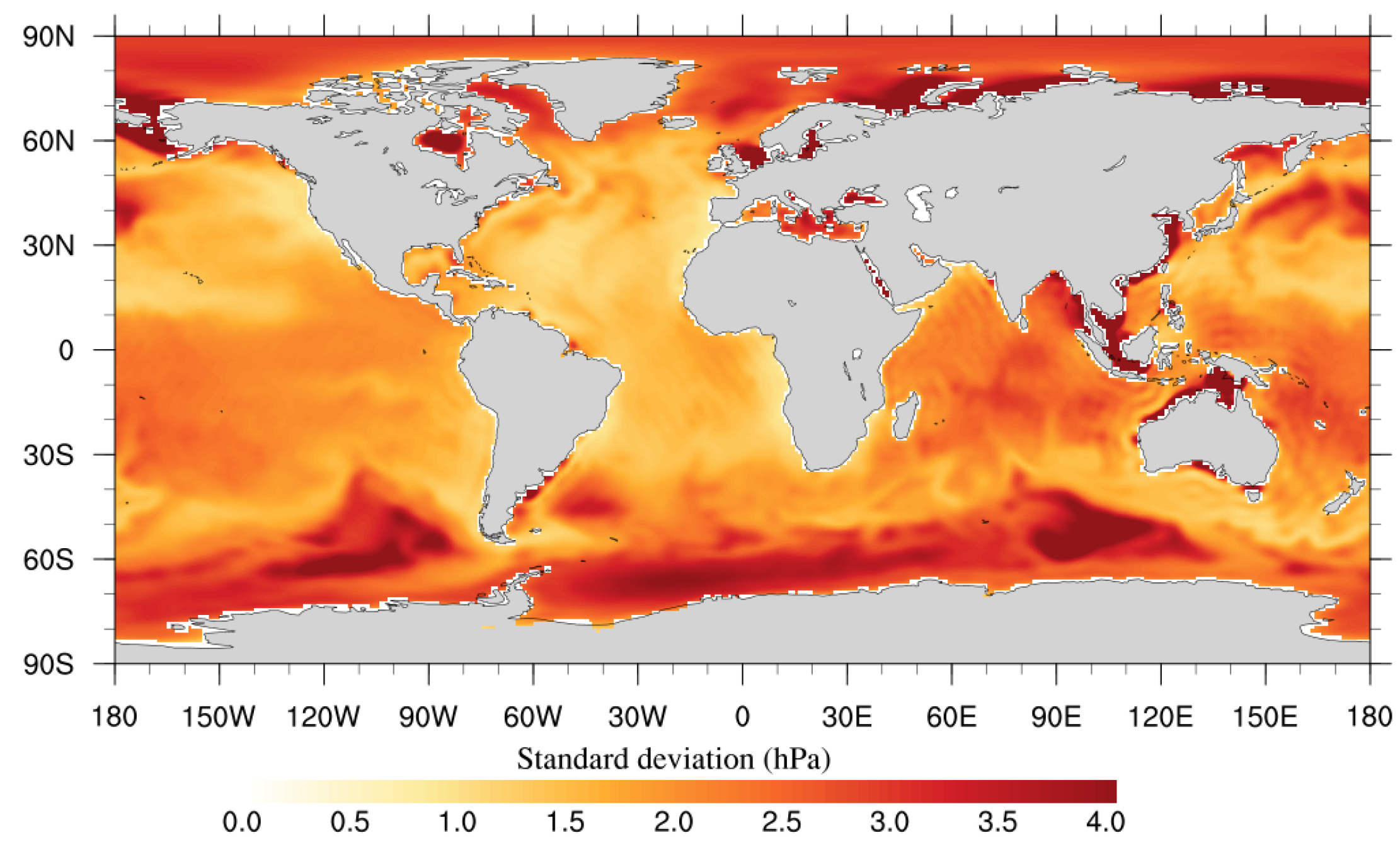
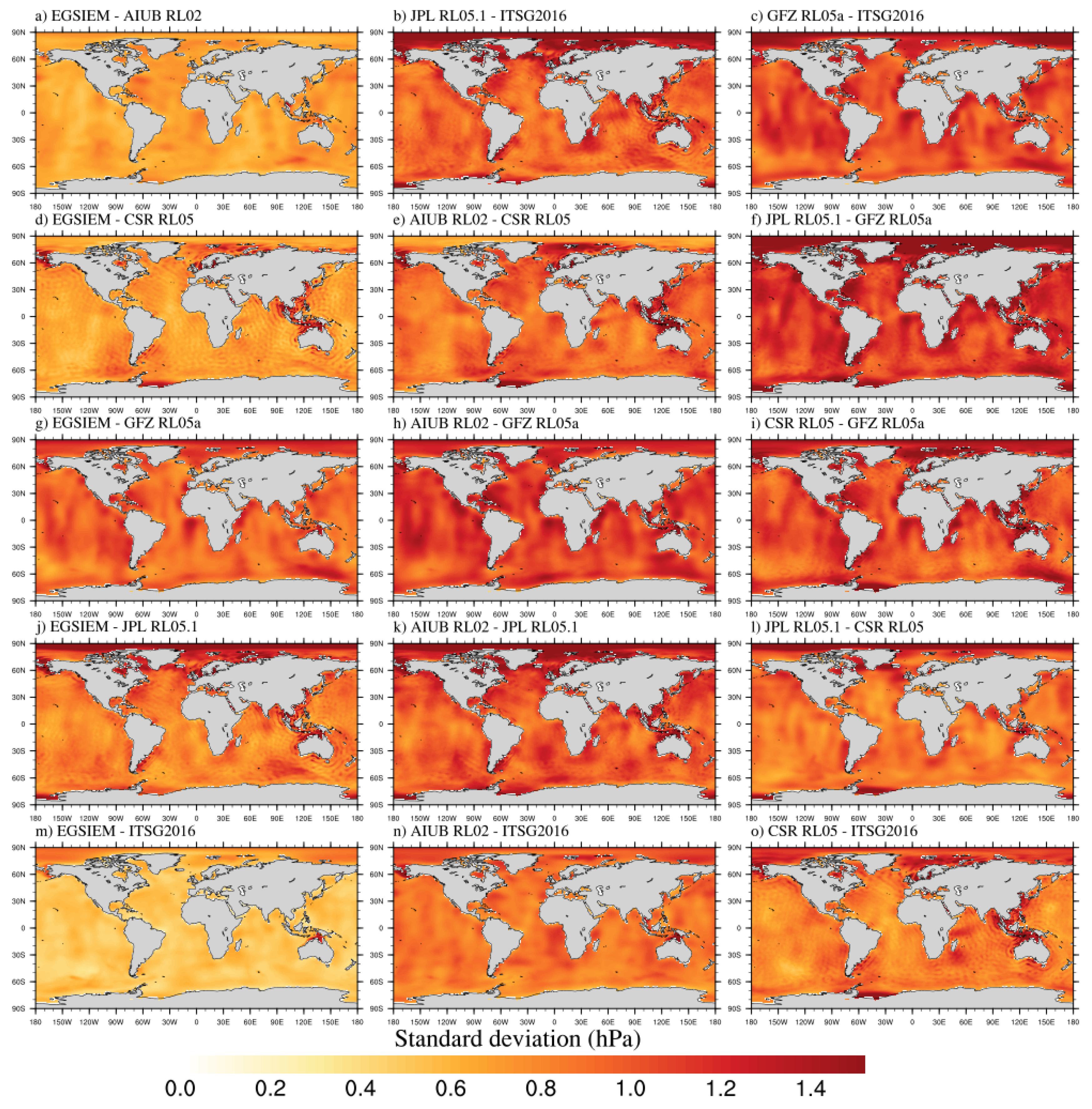
| EGSIEM-Reprocessed | ITRF2014 | JPL | ||||
|---|---|---|---|---|---|---|
| Mean (%) | Positive (%) | Mean (%) | Positive (%) | Mean (%) | Positive (%) | |
| EGSIEM combined | 23.9 | 88.1 | 20.9 | 89.2 | 16.0 | 88.8 |
| AIUB RL02 | 23.0 | 87.4 | 19.8 | 87.7 | 16.0 | 87.5 |
| CSR RL05 | 24.5 | 89.7 | 21.2 | 90.6 | 15.7 | 87.1 |
| GFZ RL05a | 21.9 | 86.9 | 18.1 | 85.8 | 13.8 | 85.9 |
| JPL RL05.1 | 22.8 | 86.9 | 19.2 | 88.4 | 15.2 | 87.7 |
| ITSG2016 | 24.5 | 90.1 | 21.1 | 89.7 | 16.1 | 87.9 |
| EGSIEM-Reprocessed | ITRF2014 | JPL | ||||
|---|---|---|---|---|---|---|
| Median (%) | Positive (%) | Median (%) | Positive (%) | Median (%) | Positive (%) | |
| EGSIEM combined | 73.5 | 87.1 | 67.7 | 89.4 | 61.4 | 78.8 |
| AIUB RL02 | 73.6 | 87.4 | 68.8 | 88.9 | 64.1 | 79.6 |
| CSR RL05 | 74.0 | 88.1 | 69.7 | 89.1 | 59.8 | 78.2 |
| GFZ RL05a | 73.5 | 88.1 | 68.4 | 89.1 | 57.8 | 77.6 |
| JPL RL05.1 | 70.1 | 86.5 | 66.8 | 88.7 | 61.6 | 80.3 |
| ITSG2016 | 73.6 | 87.8 | 69.0 | 89.7 | 60.7 | 79.0 |
| EGSIEM-Reprocessed | ITRF2014 | JPL | ||||
|---|---|---|---|---|---|---|
| Mean (%) | Positive (%) | Mean (%) | Positive (%) | Mean (%) | Positive (%) | |
| EGSIEM combined | 23.2 | 86.4 | 25.5 | 90.3 | 18.1 | 94.5 |
| AIUB RL02 | 22.3 | 85.6 | 24.6 | 88.6 | 17.7 | 91.1 |
| CSR RL05 | 23.8 | 88.1 | 25.8 | 90.7 | 18.0 | 94.1 |
| GFZ RL05a | 21.1 | 84.8 | 23.2 | 87.7 | 16.2 | 91.5 |
| JPL RL05.1 | 21.9 | 85.2 | 23.9 | 90.3 | 17.4 | 93.6 |
| ITSG2016 | 23.6 | 88.1 | 25.6 | 90.7 | 18.1 | 93.6 |
| Mean (%) | Positive (%) | |
|---|---|---|
| EGSIEM combined | −9.5 | 18.3 |
| AIUB RL02 | −31.9 | 7.2 |
| CSR RL05 | −9.1 | 15.9 |
| GFZ RL05a | −18.0 | 16.1 |
| JPL RL05.1 | −8.1 | 17.8 |
| ITSG2016 | −5.5 | 16.3 |
© 2018 by the authors. Licensee MDPI, Basel, Switzerland. This article is an open access article distributed under the terms and conditions of the Creative Commons Attribution (CC BY) license (http://creativecommons.org/licenses/by/4.0/).
Share and Cite
Chen, Q.; Poropat, L.; Zhang, L.; Dobslaw, H.; Weigelt, M.; Van Dam, T. Validation of the EGSIEM GRACE Gravity Fields Using GNSS Coordinate Timeseries and In-Situ Ocean Bottom Pressure Records. Remote Sens. 2018, 10, 1976. https://doi.org/10.3390/rs10121976
Chen Q, Poropat L, Zhang L, Dobslaw H, Weigelt M, Van Dam T. Validation of the EGSIEM GRACE Gravity Fields Using GNSS Coordinate Timeseries and In-Situ Ocean Bottom Pressure Records. Remote Sensing. 2018; 10(12):1976. https://doi.org/10.3390/rs10121976
Chicago/Turabian StyleChen, Qiang, Lea Poropat, Liangjing Zhang, Henryk Dobslaw, Matthias Weigelt, and Tonie Van Dam. 2018. "Validation of the EGSIEM GRACE Gravity Fields Using GNSS Coordinate Timeseries and In-Situ Ocean Bottom Pressure Records" Remote Sensing 10, no. 12: 1976. https://doi.org/10.3390/rs10121976
APA StyleChen, Q., Poropat, L., Zhang, L., Dobslaw, H., Weigelt, M., & Van Dam, T. (2018). Validation of the EGSIEM GRACE Gravity Fields Using GNSS Coordinate Timeseries and In-Situ Ocean Bottom Pressure Records. Remote Sensing, 10(12), 1976. https://doi.org/10.3390/rs10121976




